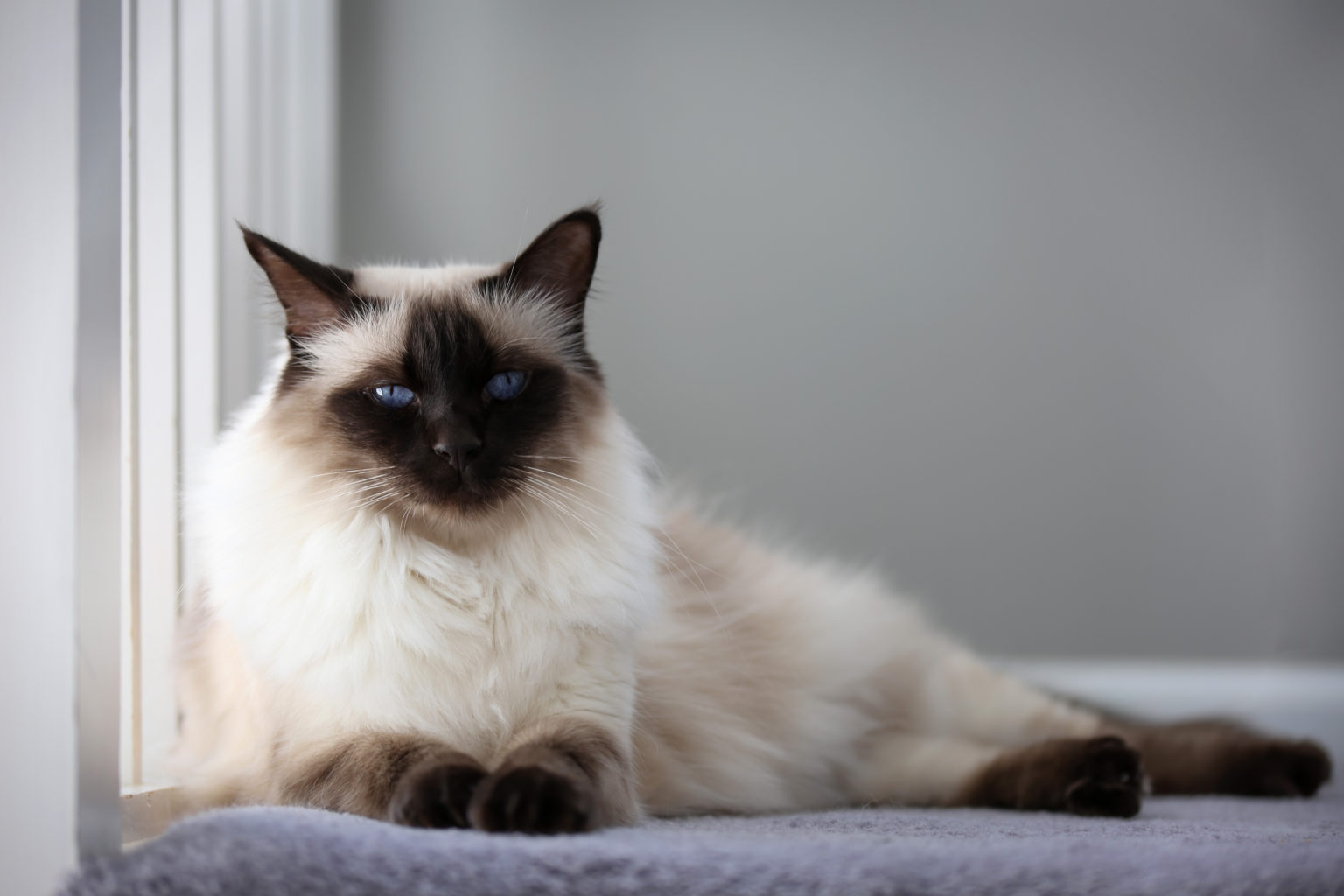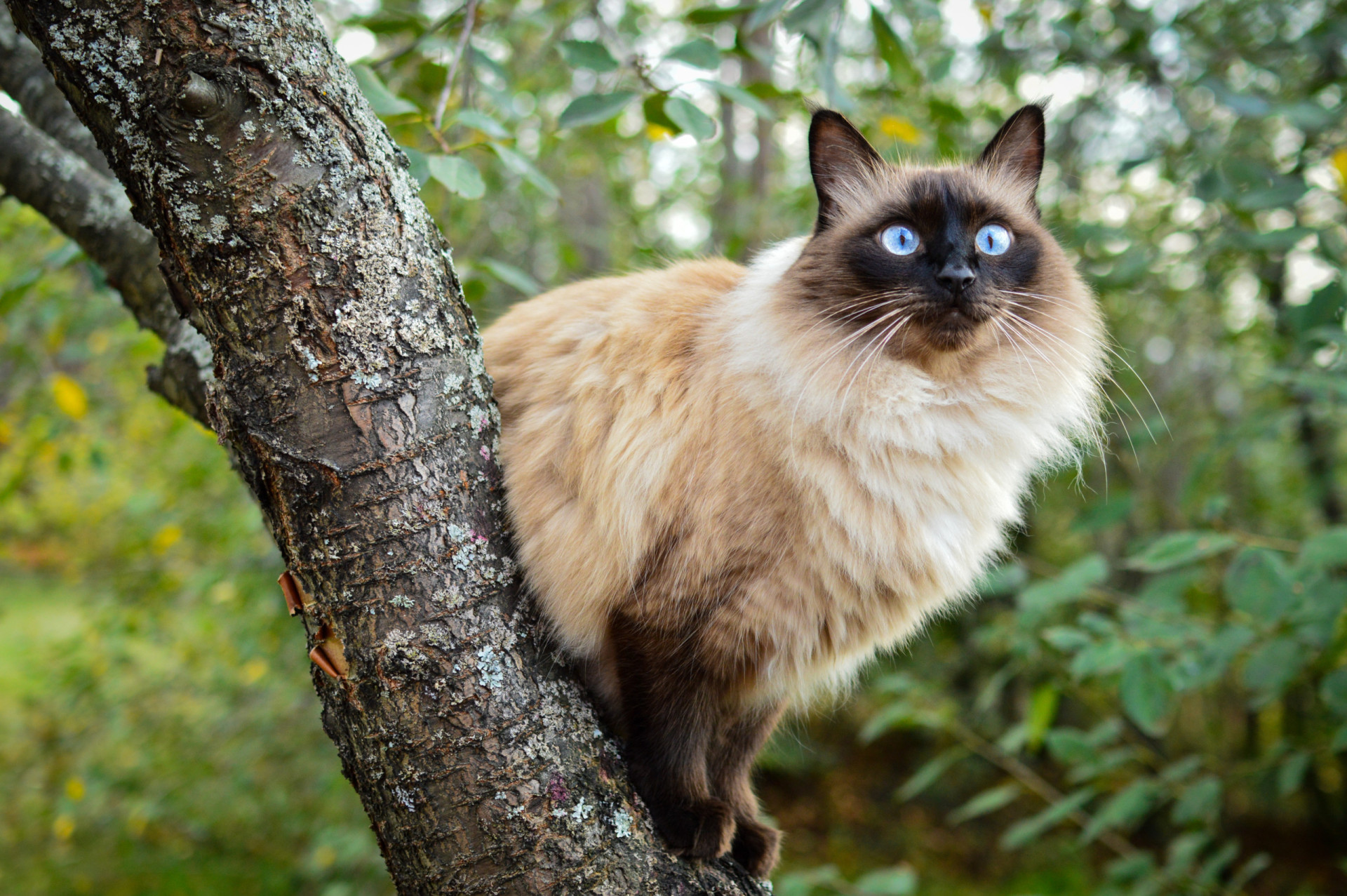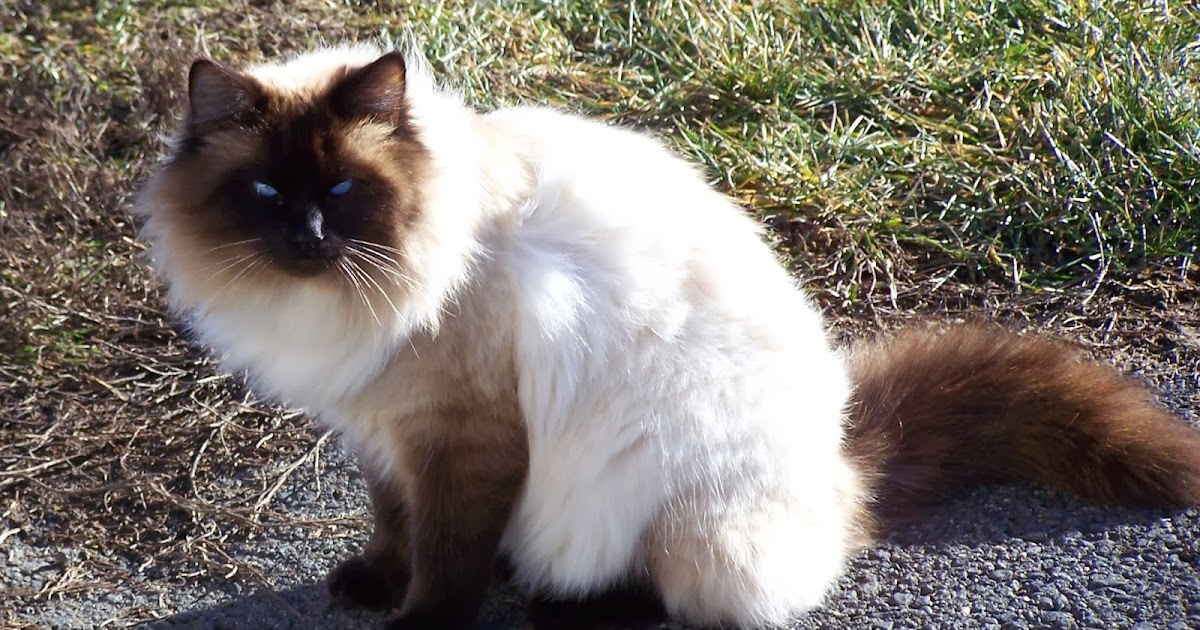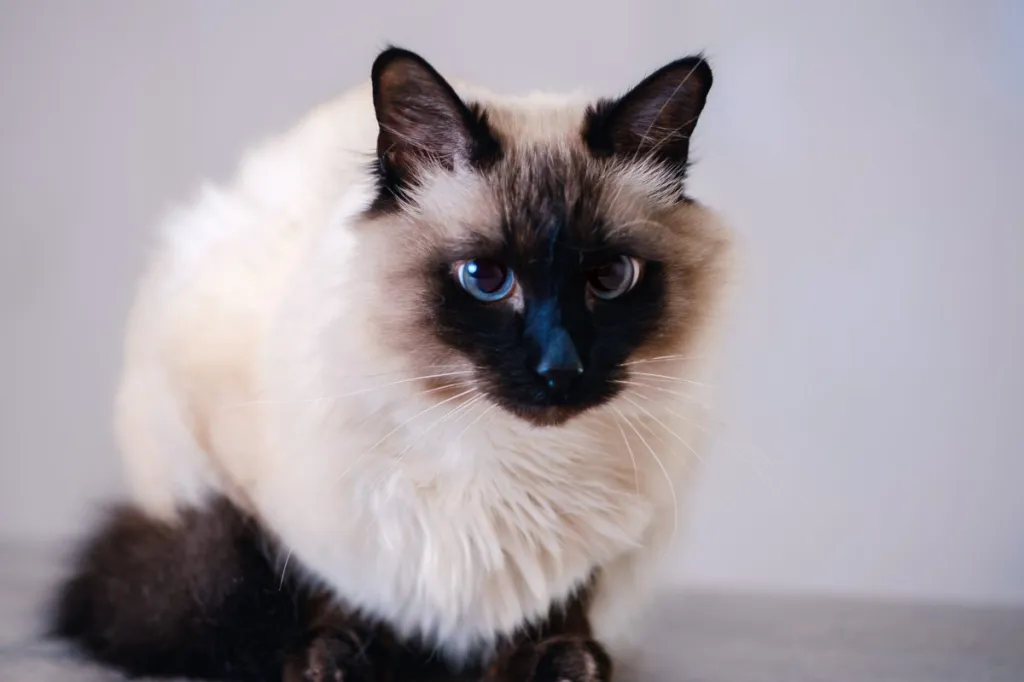Origin and History
The Balinese breed originated in the United States in the 1970s.

The Balinese is a domestic cat breed that originated in the United States in the 1970s as a result of breeding between Siamese and long-haired cats.
The name ‘Balinese’ was derived from the fact that the first Longhaired Siamese cats were referred to as ‘Balinese Cats’ due to their physical resemblance to the traditional Balinese dancers of Bali, Indonesia.
Today, the breed is recognized by most major cat registries worldwide, including the Cat Fanciers’ Association (CFA) and The International Cat Association (TICA).
The Balinese breed is known for its medium to large body size, with males typically weighing between 11-15 pounds (5-7 kg) and females weighing between 8-12 pounds (3.5-5.5 kg).
They have a wedge-shaped head with almond-shaped eyes that are slanted towards the outside corner of their eye socket.
The breed’s coat is one of its most distinctive features, featuring a fine, silky texture and a pointed pattern in a variety of colors including seal, blue, chocolate, and lilac.
The pointed pattern on the Balinese breed refers to the darker coloration of the extremities (face, ears, legs, and tail), which is in contrast to the lighter-colored fur on the body and neck.
Balinese cats are known for their playful, affectionate personalities, and they make great family pets as long as they receive sufficient attention and stimulation.
They are highly intelligent and active, requiring plenty of exercise and playtime to keep them happy and healthy.
Overall, the Balinese breed is a wonderful choice for cat fanciers who want a beautiful, outgoing companion with a lively personality.
It was developed from the Siamese breed by breeding it with a longhaired cat.
The Balinese is a breed of domestic cat known for its striking appearance and playful personality. Developed from the Siamese breed by crossing it with a longhaired cat, the result was a new and distinct breed that retained many of the characteristics of the Siamese while introducing a unique feature in the form of its long, silky coat.
The history of the Balinese breed dates back to the 1940s when it is believed that the first longhaired cats were produced by breeding Siamese with Persian or other longhaired breeds. These early attempts at developing a longhaired variant of the Siamese resulted in a number of different strains, each with its own unique characteristics.
However, it was not until the 1960s that the modern Balinese breed began to take shape as we know it today. At this time, breeders were working tirelessly to refine the breed and establish a consistent standard for the longhaired variant of the Siamese.
The Balinese is a medium-sized cat with a muscular build and a wedge-shaped head. Its eyes are almond-shaped and slanted, with an intensity that reflects its origins as a fighting breed in ancient Siam. The coat of the Balinese is one of its most distinctive features, consisting of two layers: a soft undercoat and a long, silky outer coat that falls in flowing waves to the floor.
The color point pattern of the Balinese is similar to that of the Siamese, with points on the face, ears, legs, and tail. However, whereas the Siamese has a solid white background color, the Balinese has a creamy or milk-chocolate base coat with a subtle sheen.
The temperament of the Balinese cat is often described as outgoing and affectionate. They are highly social animals that thrive on human interaction and attention. Playful and curious, they enjoy interacting with toys and other objects in their environment.
As a breed, the Balinese has several health concerns to watch out for. These include crossed eyes, patellar luxation, and hip dysplasia. Regular veterinary care and genetic testing can help identify potential issues early on.
In terms of grooming needs, the Balinese requires regular brushing to prevent matting and tangling of its long coat. A weekly or biweekly grooming session should be sufficient to keep the cat’s coat looking its best.
Overall, the Balinese is a delightful and charming breed that makes a wonderful companion for families and individuals alike. Its striking appearance and playful personality have earned it a special place in the hearts of many cat lovers around the world.
Physical Characteristics
The Balinese has a mediumlength coat that is silky and fine to the touch.
The Balinese cat breed is known for its stunning appearance and elegant demeanor. One of the most distinctive features of this breed is their coat, which is characterized by a medium length that is silky to the touch.
The silky texture of the Balinese’s coat is one of its defining characteristics. It is incredibly soft and fine, with a subtle sheen that catches the light. The coat itself is typically described as having a gentle wave or ruff around the neck and shoulders, which adds to its overall air of refinement.
The coat length of the Balinese cat breed can vary slightly from one individual to another, but on average it falls within the medium-length category. This means that they have a good amount of fur covering their body, without being so long as to become cumbersome or difficult to maintain.
The coloration of the Balinese coat is also noteworthy. They come in a range of colors and patterns, including solid, pointed, and bi-color varieties. The most common color for this breed is blue-point, which features a striking contrast between the darker points on their extremities and the lighter overall tone of their coat.
The grooming needs of the Balinese cat breed are relatively low, considering the length and texture of their coat. This may come as a surprise to some, but in reality, these cats are quite easy to maintain. A weekly brushing or combing session is usually sufficient to keep their coat looking its best.
In addition to their beautiful appearance, Balinese cats are also known for their intelligent and outgoing personalities. They are highly social animals that thrive on interaction and attention from their human family members. As such, they make great companions for those who enjoy engaging in play or simply want a loving friend to curl up with.
The lifespan of the Balinese cat breed is typically quite long, with many individuals living well into their teens and sometimes even beyond. This makes them a great choice for families or individuals looking for a low-maintenance companion that will provide years of love and companionship.
The coat can be in a variety of point colors including seal, chocolate, blue, lilac, red, cream, and platinum.
The Balinese cat is a stunning feline breed known for its beautiful coat colors that come in a variety of point colors. These colors are a result of the interaction between two different types of melanin – eumelanin and phaeomelanin. The point colors can be quite diverse, including seal, chocolate, blue, lilac, red, cream, and platinum.
Each of these coat colors has its own unique characteristics that contribute to the overall appearance of the Balinese cat. For instance, the seal color is a deep brown-red shade, while the chocolate point color is a warm golden-brown hue. The blue point color, on the other hand, is a cool grey-blue tone that adds a sophisticated touch to the cat’s appearance.
The lilac point color is a pale pastel pinkish-grey shade that gives the Balinese cat a delicate and dainty look. Meanwhile, the red point color is a vibrant fiery orange-red hue that adds a bold and striking touch to the cat’s coat. The cream point color, as its name suggests, has a creamy off-white tone with a golden undertone.
Lastly, the platinum point color is an extremely rare and beautiful shade that has a silvery-grey tone with a hint of blue undertones. It’s worth noting that each of these point colors can appear in different shades and intensities depending on the individual cat’s genetics.
In addition to their striking coat colors, Balinese cats are also known for their stunning medium-length coats that require regular grooming. Their fur is soft, silky, and fine to the touch, with a subtle sheen that catches the light. The coat pattern typically features a pointed or mitted face mask, with white fur on the paws, chest, belly, and sometimes on the forehead.
Overall, the Balinese cat’s diverse range of point colors makes them one of the most visually stunning breeds in the feline world. Whether you prefer a bold red or a delicate lilac, there’s sure to be a Balinese cat out there that will catch your eye and capture your heart!
Personality and Temperament
The Balinese is known for being intelligent and active.

The Balinese cat breed has long been renowned for its exceptional intelligence and high energy levels, making it an ideal companion for active families or individuals who enjoy engaging in stimulating activities.
One of the most striking features of the Balinese is its sleek and agile physique, which allows it to easily navigate stairs and participate in playtime with minimal effort.
This breed’s intelligence extends beyond basic problem-solving skills, as they have been observed to exhibit a keen sense of curiosity and a strong desire to interact with their human family members.
They are known to form deep bonds with their owners, often exhibiting affectionate behaviors such as rubbing against legs, purring loudly, and even demanding attention by vocalizing in a sweet, chirping tone.
Balinese cats require regular exercise to maintain their physical health and mental well-being, which can be achieved through playtime activities like chasing laser pointers or playing with feather toys.
They are also known for being highly trainable, responding eagerly to commands and adapting quickly to new routines, making them an excellent choice for families with children who need guidance on how to care for a pet.
The Balinese breed’s high energy levels can be managed with regular grooming sessions, which help keep their coat clean, shiny, and healthy, while also reducing the risk of hairballs or shedding-related problems.
While they may appear fragile due to their slender build, the Balinese is generally a sturdy breed that can live up to 12-17 years with proper care and attention, making them a long-term companion for many families.
In conclusion, the Balinese cat breed’s exceptional intelligence and high energy levels make it an excellent choice for active families or individuals who are willing to invest time and effort into providing regular exercise, playtime, and affectionate interaction.
It is also known for its loyalty and affection towards its owners.
The Balinese cat breed is renowned for its extraordinary loyalty and affectionate nature towards its owners. This trait is a testament to their strong bond with humans and makes them an ideal companion for many families.
One of the most notable characteristics of the Balinese breed is their deep-seated desire to be around people. They have a natural tendency to crave human interaction, often seeking out attention and affection from their owners at every opportunity.
This loyalty and affection towards humans are deeply rooted in their history as temple cats in Bali, where they were highly revered for their skills as hunters and companions. In these settings, the Balinese developed strong bonds with the monks who cared for them, learning to rely on human support and interaction for survival.
Today, this innate loyalty and affection remain a hallmark of the breed, making them an excellent choice for families or individuals seeking a constant companion that will always be by their side. Their loving nature and playful personalities make them an excellent fit for households with children, while their intelligence and trainability make them well-suited for owners who enjoy interactive play.
Additionally, the Balinese breed is known for its adaptability to new environments and situations, making them a great choice for families who frequently change homes or travel extensively. Their calm and gentle demeanor also makes them an excellent fit for households with multiple pets, where they will often get along peacefully with other animals.
Overall, the Balinese cat breed’s exceptional loyalty and affection towards its owners make them a beloved companion for many families around the world. With their natural intelligence, playfulness, and adaptability, it is no wonder that this breed remains one of the most popular among feline enthusiasts.
Care and Grooming
The Balinese requires regular grooming to prevent matting and tangling of the coat.
The Balinese is a sleek and slender feline breed that requires regular grooming to prevent matting and tangling of their coat. As a medium-length coated breed with a silky texture, they are prone to knotting and tangling if not groomed regularly.
To maintain the health and appearance of their coat, Balinese cats require daily brushing using a slicker brush or a pin brush to remove loose hair and prevent matting. It’s essential to be gentle when brushing to avoid causing any discomfort or pain to the cat.
As well as regular brushing, Balinese cats also need their nails trimmed regularly to prevent overgrowth, which can cause discomfort and health problems. The cat’s nail should be trimmed every few weeks using a pair of cat nail clippers specifically designed for this purpose.
Bathing is not typically necessary for Balinese cats as they are relatively clean animals and groom themselves regularly. However, if your Balinese cat does require a bath, it’s essential to use a mild shampoo and lukewarm water to avoid causing any irritation or dryness to their skin.
Despite their low-maintenance grooming needs in terms of bathing, Balinese cats do require regular eye and ear cleaning. This can be done using a damp cloth to clean around the eyes and a cotton ball to gently wipe away any dirt or debris from the ears.
To prevent hairballs and other digestive issues, it’s also recommended to brush your Balinese cat’s coat regularly and provide them with plenty of fresh water. A balanced diet that meets their nutritional needs is essential for maintaining a healthy coat and preventing digestive problems.
Regular grooming not only helps to prevent health problems but also strengthens the bond between you and your Balinese cat. It’s an excellent way to spend quality time together and enjoy the benefits of petting, brushing, and interacting with one another.
Overall, regular grooming is a crucial aspect of caring for a Balinese cat. By following these simple tips and maintaining a consistent grooming routine, you can help to keep your Balinese cat’s coat healthy, shiny, and free from matting and tangling.
It also requires nail trimming, ear cleaning, and dental care.

The Balinese is a stunning cat breed that originated from the Siamese, but with a beautiful longhaired coat. One of the key characteristics of this breed is their elegant appearance, with a slender build and striking feline features.
In terms of grooming, the Balinese requires regular attention to maintain its stunning coat length. This includes nail trimming, which should be done every few weeks to prevent overgrowth. Long nails can cause discomfort and even injury to your cat, so it’s essential to keep them trimmed.
The Balinese also requires regular ear cleaning to maintain good ear health. Dirty ears can lead to infections, which can be painful and uncomfortable for your cat. Cleaning their ears regularly will help prevent this from happening.
In addition to nail trimming and ear cleaning, the Balinese also needs regular dental care. This includes brushing their teeth regularly to remove plaque and tartar buildup, which can cause bad breath and gum disease if left unchecked.
It’s essential to establish a routine for grooming your Balinese cat, as this breed requires regular attention to maintain its stunning appearance. Regular grooming will also help prevent health problems such as nail overgrowth, ear infections, and dental issues.
Overall, the Balinese is a beautiful and charming breed that requires careful attention to maintain its stunning coat length. With regular nail trimming, ear cleaning, and dental care, you can keep your Balinese in top condition and enjoy many happy years with this wonderful companion.
Health
The Balinese is generally a healthy breed with an average lifespan of 1215 years.
The Balinese is a breed of domestic cat known for its striking appearance and gentle disposition. This breed originated from the cross between a Siamese and a long-haired cat, resulting in a unique combination of physical characteristics and temperamental traits.
In terms of health, the Balinese is generally considered to be a healthy breed with a relatively long lifespan compared to other domestic cats. On average, the lifespan of a Balinese cat ranges from 12 to 15 years, although some individuals have been known to live up to 20 years or more with proper care and nutrition.
The longevity of this breed can be attributed to several factors, including its genetic makeup and environmental influences. Regular veterinary check-ups, a balanced diet, and a safe living environment all contribute to the overall health and well-being of a Balinese cat.
In addition to their long lifespan, Balinese cats are also known for their striking appearance. They have a sleek, fine coat that is typically blue, chocolate, or cream in color, with a subtle sheen that catches the light. Their eyes are almond-shaped and slanted, giving them an exotic and mystical appearance.
The Balinese breed is also prized for its gentle and affectionate nature. They are highly social animals that thrive on human interaction and attention, making them ideal companions for families or individuals who value a strong bond with their pet.
In terms of grooming, Balinese cats require regular maintenance to prevent matting and tangling of their coat. Daily brushing is recommended to keep their fur clean and healthy, although this can be time-consuming and may not be suitable for every owner.
Overall, the Balinese breed offers a unique combination of physical characteristics, temperamental traits, and longevity that makes them an attractive choice for cat fanciers. With proper care and attention, these beautiful cats can thrive and bring joy to their owners for many years to come.
However, it can be prone to certain health issues such as patellar luxation and progressive retinal atrophy.
The Balinese is a breed of domestic cat known for its striking appearance and playful personality. However, it can be prone to certain health issues that potential owners should be aware of.
One common health issue affecting the Balinese breed is patellar luxation. This condition occurs when the kneecap slips out of place, causing discomfort and pain for the cat. Patellar luxation can be caused by a variety of factors, including genetics, obesity, and joint problems.
Cats with patellar luxation may exhibit symptoms such as skipping or hopping to avoid putting weight on the affected leg. In severe cases, surgery may be necessary to correct the issue and prevent further complications.
Another potential health concern for Balinese cats is progressive retinal atrophy (PRA). This condition affects the retina of the eye, causing gradual vision loss and potentially leading to blindness.
PRA can be caused by a combination of genetic and environmental factors. Cats with PRA may exhibit symptoms such as sensitivity to light, difficulty navigating stairs or jumps, and increased dependence on their owners for mobility.
It’s essential for potential Balinese cat owners to understand the risks associated with these health issues and take steps to prevent or manage them. This can include regular veterinary check-ups, maintaining a healthy weight through diet and exercise, and providing a safe and stimulating environment for your cat to thrive in.
Certification
The Balinese is recognized by the Cat Fanciers’ Association (CFA) and other major cat registries.
The Balinese is a breed of domestic cat known for its striking appearance and playful personality. It is recognized by the Cat Fanciers’ Association (CFA) and other major cat registries, including the International Cat Association (TICA) and the American Cat Fanciers Association (ACFA). The breed’s unique characteristics have made it a popular choice among cat fanciers.
Origin of the Balinese is not well-documented, but it is believed to have originated in the 1960s as a natural mutation of the Siamese breed. The first Balinese cats were born in the United States and quickly gained popularity among cat fanciers due to their striking appearance and playful personality.
The Balinese is characterized by its medium-length coat, which is soft and silky to the touch. The coat comes in a variety of point colors, including seal, blue, chocolate, and lilac. The points on the Balinese are darker than the body, giving the breed a striking appearance. In addition to its coat color, the Balinese is also known for its green or gold eyes.
Physical Characteristics of the Balinese include a slender build, with males weighing between 11 and 15 pounds (5-7 kg) and females weighing between 8 and 12 pounds (3.5-5.5 kg). The breed’s head is wedge-shaped, with a flat forehead and a long, pointed muzzle.
The Personality of the Balinese is playful, curious, and affectionate. They are highly intelligent and active cats that require regular exercise to stay happy and healthy. In addition to their physical characteristics, the Balinese is also known for its vocal nature, with many owners describing them as “talkative.” They are highly social cats that thrive on human interaction and attention.
Care and Grooming of the Balinese require regular grooming to prevent matting and tangling of the coat. The breed’s medium-length coat requires daily brushing, with a weekly bath also recommended to keep it clean and healthy. Regular nail trimming, ear cleaning, and dental care are also essential for maintaining the overall health of the Balinese.
The Health of the Balinese is generally good, but like all breeds, they can be prone to certain health issues. The most common health issues affecting the breed include patellar luxation, hip dysplasia, and hypertrophic cardiomyopathy (heart disease). Regular veterinary check-ups and genetic testing are essential for identifying potential health problems early on.
Overall, the Balinese is a beautiful and charming breed that makes an excellent companion cat. With its striking appearance, playful personality, and low-maintenance grooming requirements, it’s no wonder why this breed has become so popular among cat fanciers worldwide.
- Best Dun & Bradstreet (DNB) Alternatives for 2025 - April 19, 2025
- Best 6sense Alternatives for 2025 - April 18, 2025
- Best Instantly.ai Alternatives for 2025 - April 18, 2025



